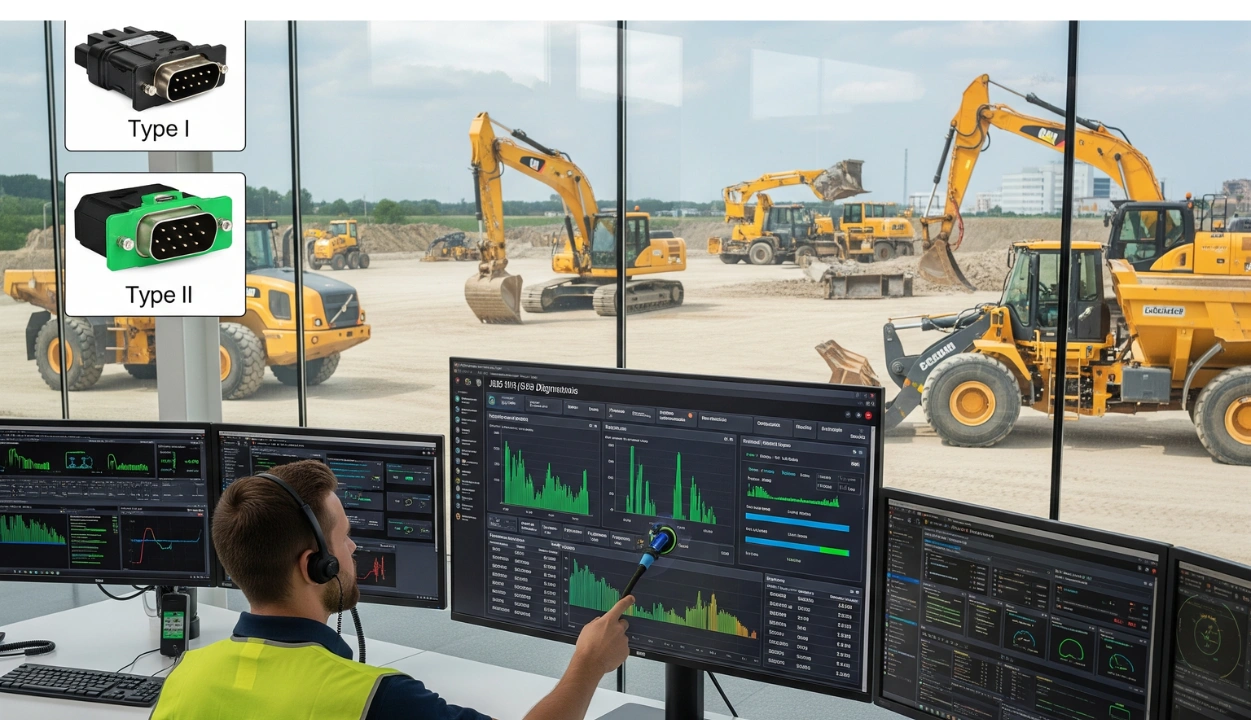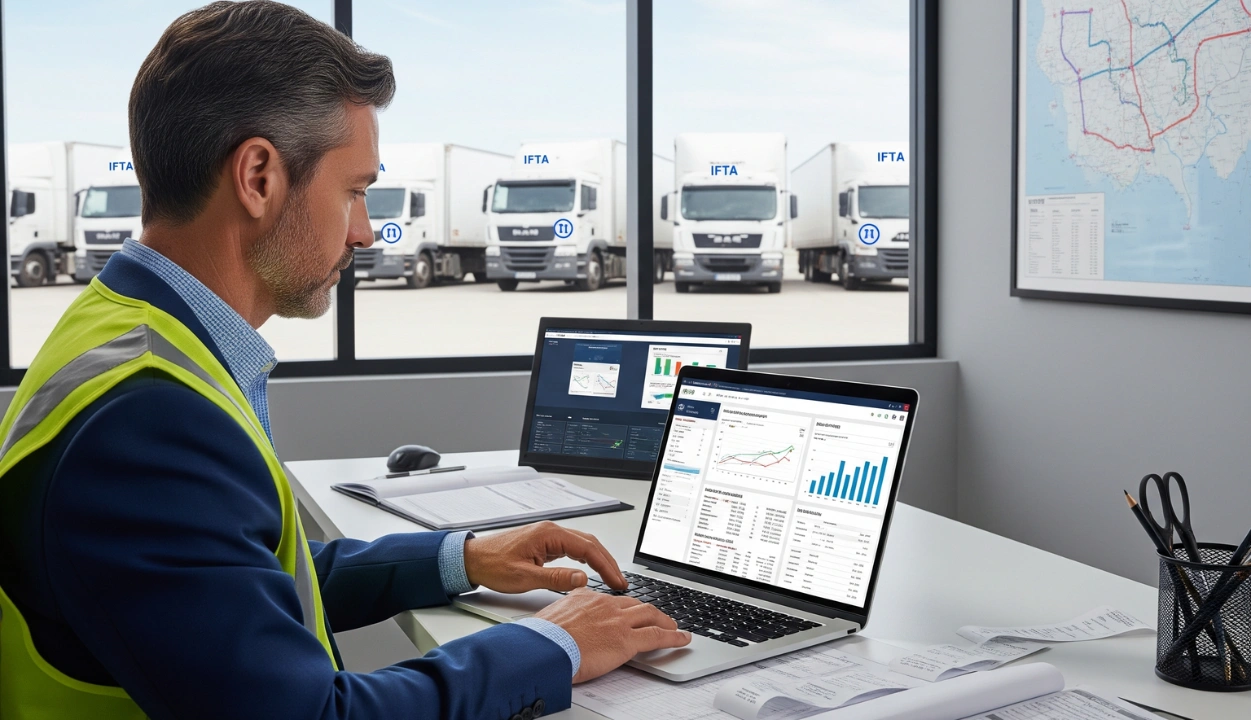What Are Fleet Compliances?
Construction fleets live a double life: OSHA rules on the jobsite, DOT/FMCSA rules the second your iron hits public roads. That’s where “fleet compliance” stops being a buzzword and becomes your day-to-day operating system.
It is the basis of ensuring that all the drivers you hire and retain are qualified, limits on their hours legal, vehicles roadworthy, loads secured, documentation legally correct, etc. so that roadside inspections, audits, insurance reviews, client prequels and other scrutiny habits blow up your schedule and your margins.
If you run dump trucks, lowboys, mechanics’ rigs, fuel/lube trucks, or half-ton pickups towing equipment, you’re managing risk at 60 mph. Miss a maintenance interval, pencil-whip an inspection, or fudge HOS and you’re courting fines, out-of-service ord-ers, and lawsuit fuel.
Get it right and compliance quietly underpins everything you care about: safety, uptime, cost control, and credibility with GC/owner teams.
This guide treats compliance like what it is a core business function. We’ll translate the rulebook into construction reality, show you what “good” looks like, and give you a pull-through playbook you can implement without melting your calendar.
What “Fleet Compliance” Actually Means
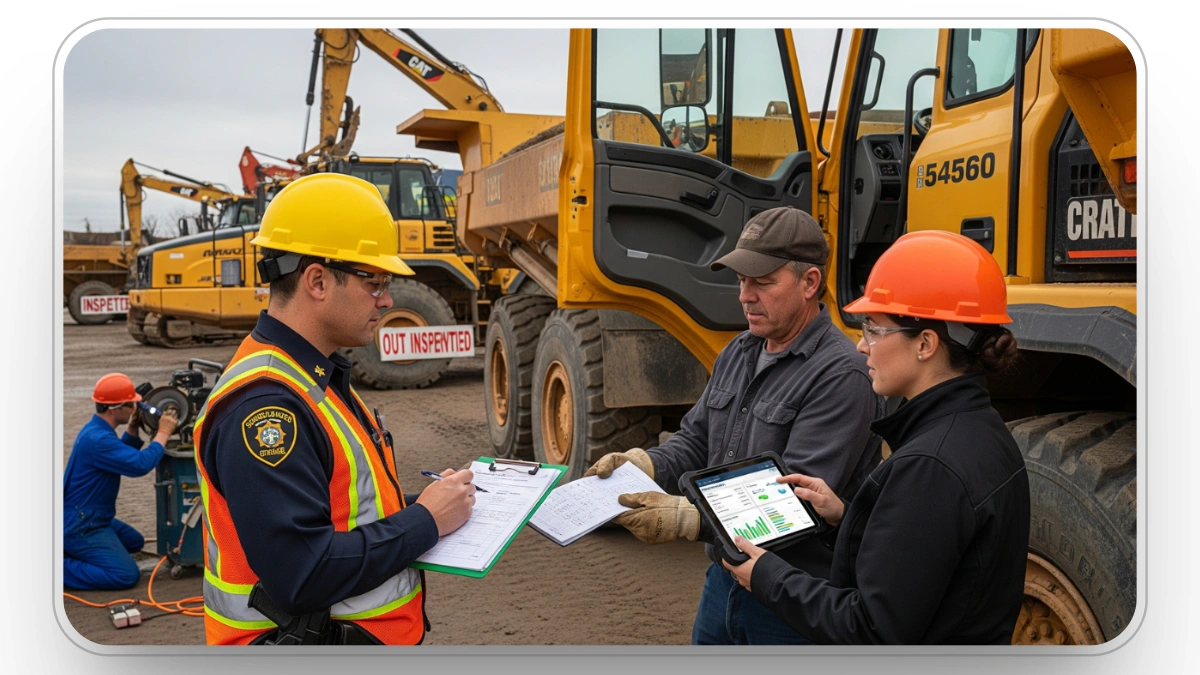
Fleet compliance is the ongoing discipline of keeping vehicles, drivers, operations, and records aligned with U.S. federal and state rules, primarily FMCSA and DOT and being able to prove it during roadside inspections, audits, insurance reviews, and litigation.
On the job site, OSHA laws apply and when you roll on the road, FMCSA/DOT laws take control. The key areas of focus are on driver qualifications, Hours of Service (HOS) and ELDs, inspections/ DVIRs and maintenance, load securement/weight, IFTA fuel tax (if interstate), CSA scores, and assiduous record keeping.
Industry guides consistently frame compliance as both risk control and operational hygiene and they emphasize technology to make it repeatable.
Who’s In Scope (and Why Construction Gets Caught Fast)
Most construction fleets qualify as CMVs sooner than they think. This section shows how vehicle weight, trailers, and specific use cases pull you under FMCSA rules, even if you’re “just” hauling tools to the job.
Commercial Motor Vehicle (CMV) thresholds (the 10,001-lb trap)
A vehicle/combo can weigh 10,001 lb or more GVWR/GCWR and fall under the number of most FMCSA regulations, if you are engaged in interstate commerce. That is the total GVWR of a pickup/trailer, a thing quite likely to trip up construction outfits when pulling equipment.
Quick check
- Truck GVWR + trailer GVWR ≥ 10,001 lb? You’re in CMV land.
- Hauling hazardous materials requiring placards? You’re in—even if lighter.
The Regulatory Pillars
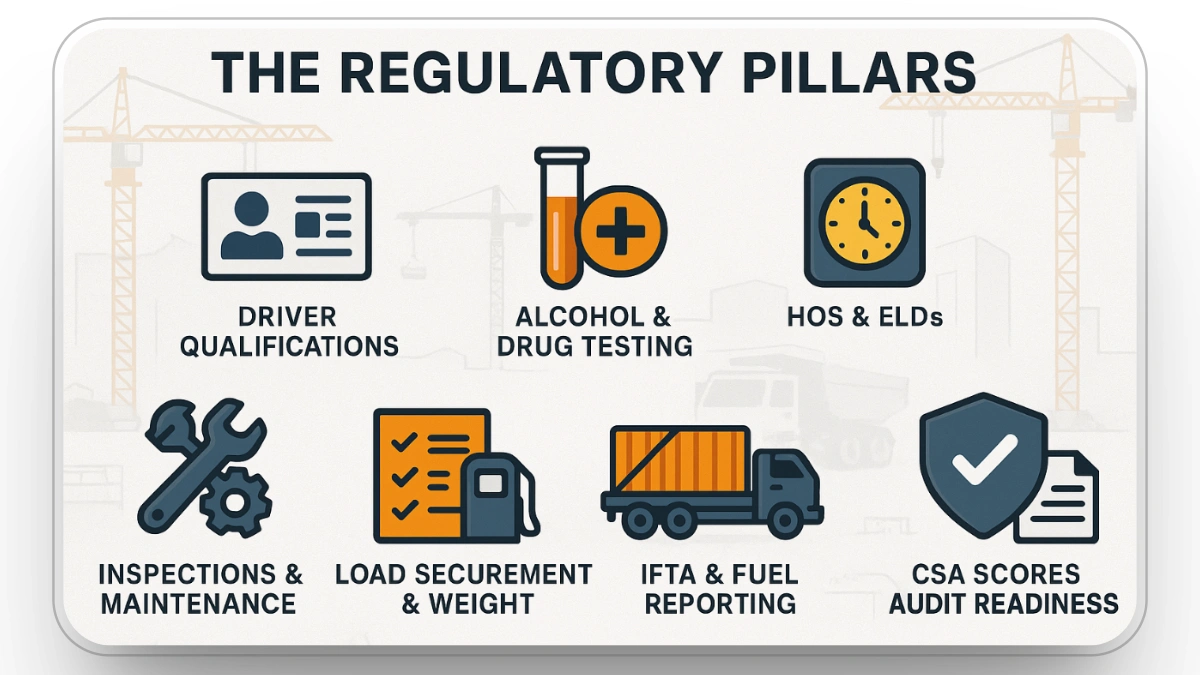
Consider compliance to be six support pillars: driver qualifications, HOS/ELDs, inspections and maintenance, securement and weight, IFTA, and CSA.
Here’s what each pillar demands and how they fit together day-to-day.
1. Alcohol Testing
Qualified refers to having proper licensing (CDL class/endorsements where applicable), medically qualified and enrolled in a drug and alcohol testing program (pre-employment, random, post accident, etc.).
Maintain Driver Qualification Files (DQFs), License / endorsement copies, med cards, MVR checks, training, it is the first place that auditor will start with. Downloadable checklists invariably categorize DQFs, MVR discipline and random testing as the first item on the agenda.
2. Construction Nuance
Service pickups and yard trucks often rotate between drivers; without a clear DQF and assignment process, audits get messy fast. Industry checklists recommend centralized, digital DQFs with expiry alerts.
3. Hours of Service (HOS) & Electronic Logging Devices (ELDs)
The fundamental hours of service under the driving restriction entail: 11 hours of operating in 14 consecutive hours of work following 10 hours off duty and half an hour break followed by 8 immediate continuous hours of operating; 60 and 70 hours limitations in 7 and 8 days consecutively with 34 hour exemption.
The vast majority of drivers that are required to maintain RODS require ELDs, short-haul exemptions are smaller than you might think.
Reality check: Roadside and audit teams scrutinize unassigned/“logged-out” miles, edits without annotations, and recurring break violations. ELDs reduce paperwork but increase traceability, plan for policy, training, and enforcement.
4. Inspections, DVIRs & Preventive Maintenance
Drivers must inspect vehicles daily. DVIR rule: property-carrying CMV drivers file a DVIR only if a defect/deficiency is found; passenger-carrying drivers file regardless.
Motor carriers must retain DVIRs with defects and repair certifications; and keep maintenance records on each unit. Construction fleets that bake DVIRs into a fast e-workflow and tie them to work orders avoid most scale-house surprises.
What to inspect
Brakes, tires/wheels, lights, steering, coupling, mirrors, windshield wipers, emergency equipment, and any body/bed/tarp hardware used in construction hauling- industry checklists reflect FMCSA priorities.
5. Load Securement, Weight/Size, and Special Permits
Pipes, rebar, attachments, and machines must be secured to standard; oversize/overweight moves require permits and routing.
Scale houses will check axle and gross weights; non-compliant loads get parked, and jobs get delayed. Industry primers remind fleets that securement and weight are top out-of-service drivers in construction hauling.
6. IFTA & Fuel/Distance Reporting (Interstate Fleets)
Operate qualifying vehicles across state lines?
You’ll need IFTA: an annual license and decals, and quarterly fuel-tax returns based on miles and fuel by jurisdiction.
Some states allow occasional-trip permits in lieu of full IFTA for infrequent interstate travel. Modern fleet cards/telematics can automate most of this.
7. CSA Scores & Audit Readiness
Inspection and crash data are fed into CSA BASIC s (Unsafe Driving, HOS, Driver Fitness, Vehicle Maintenance, Controlled Substances / Alcohol, Crash Indicator, HazMat). These patterns of violation raise red flags that set off countermeasures, and damage bid credibility.
Guides across the industry stress a posture of “audit-ready, always”—clean documentation, rapid corrective action, and leadership accountability.
The Tech Stack That Keeps You Compliant
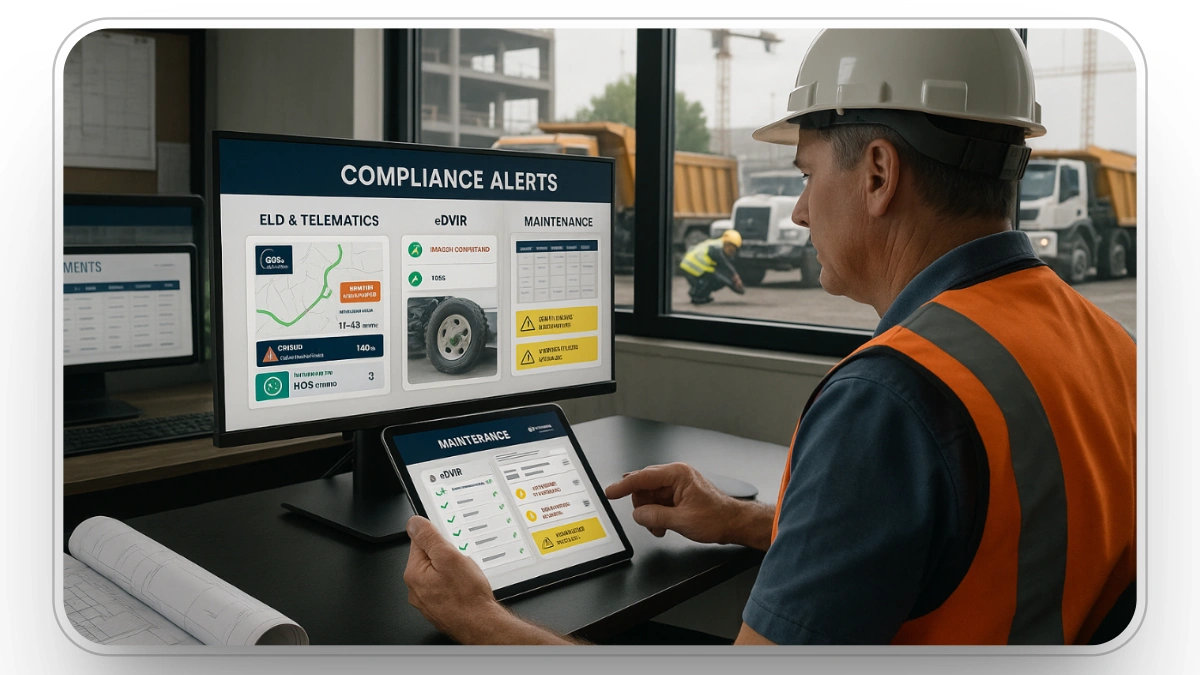
Paper can’t keep up with modern fleets. Here’s the minimum viable stack, ELD/telematics, eDVIR, maintenance, and document control that turns compliance from fire drills into routine.
- ELD + Telematics: Modern platforms combine ELDs, GPS, driver coaching, harsh-event detection, and sometimes dashcams in one pane of glass. They flag HOS risks, unassigned driving, speeding, and seat-belt violations, helping supervisors coach in real time and “ace inspections” with accurate logs.
- eDVIR & Maintenance Software: Drivers hate paper. eDVIR reduces pencil-whipping by making inspections faster (checklists + photos) and routing defects straight to maintenance. Combine it with a PM planner (mile/hour/time-based) and eWork orders in order to complete the loop and keep evidence in front of inspectors.
- Compliance Dashboards & Document Control: Track and manage DQFs, licenses, med cards, insurance certs, annual inspections, permits, and policy acknowledgments including expiry alerts and exporting audits with a single click.The compliance guides all converge on the same advice: organize, digitize, and alert so nothing lapses.
A Practical Implementation Roadmap
No theory, just sequence. Follow these steps to stand up policy, tools, training, and audits in a way that sticks without melting your calendar.
1) Inventory & Classify
List every asset with GVWR/GCWR, usage (interstate/intrastate), and special categories (HazMat, oversize/overweight). Identify which drivers require CDLs/endorsements and enroll all CMV drivers in drug/alcohol testing. Build or migrate DQFs to a digital system with expiry alerts.
2) Write Policy—Then Train to It
Publish a Fleet Safety & Compliance Policy covering inspections, HOS/ELD use, load securement, speed/seat belts/phones, incident reporting, and corrective actions. Then train: onboarding + refreshers + supervisor spot-checks. Construction fleets should add modules for tie-down methods, tarping, and work-zone operations.
3) Stand Up the Tools
Deploy an integrated ELD/telematics + eDVIR + maintenance stack; connect fuel cards/odometer feeds for IFTA. Configure role-based dashboards (safety, dispatch, shop, finance). The glossaries and guides emphasize that software turns compliance from a frantic month-end ritual into a daily routine.
4) Preventive Maintenance > Corrective Firefighting
Use manufacturer schedules and operating reality (dust, duty cycles) to set PM intervals by unit type and meter (miles/hours). Auto-trigger work orders before due dates. Keep annual inspection proofs with the unit’s record. Construction conditions are hard on brakes, tires, lights, schedule checks accordingly.
5) Data Discipline & Audit Readiness
Digitize everything and retain per rule (e.g., DVIRs with defects and repairs; HOS records; annual inspections). Build a quarterly self-audit: sample DQFs, logs vs. GPS breadcrumbs, and close findings with written corrective actions.
6) Coach Drivers with Telematics
Use event-based coaching (speeding, harsh braking, seat belts) and HOS alerts to prevent violations. Forum discussions from U.S. drivers/managers repeatedly highlight the value of coaching and clear escalation paths; they also warn that “logged-out” miles get scrutinized.
7) Bring in a Compliance Pro
New entrants and fast-growing fleets benefit from DOT compliance consultants who tune files, policies, and IFTA/HOS processes and prepare you for audits. Reddit threads from carriers and brokers frequently recommend seasoned compliance firms to avoid rookie mistakes.
Common Construction-Fleet Mistakes (and How to Avoid Them)
These are the traps that burn budgets and CSA scores. Use this checklist to spot and fix the usual suspects before an inspector does.
- Misclassifying CMVs: That ¾-ton pickup + loaded equipment trailer often crosses 10,001 lb GCWR; pretending it doesn't fly at a scale. Measure and document.
- DVIR Lip Service: Inspections are required every day; for property-carrying CMVs, DVIRs are required when a defect exists, but many fleets either file pointless “no-defect” DVIRs or pencil-whip real issues. Move to eDVIR with photos and auto-work-orders.
- ELD Sloppiness: Unassigned miles, missing break annotations, and “ghost driving” surface later in audits and hurt CSA. Set edit policies, train, and enforce with coaching.
- IFTA as a Quarter-End Panic: Manual spreadsheets explode. Use integrated mileage-by-jurisdiction plus fuel card feeds to make quarterly filings a non-event, or use trip permits if you only rarely travel interstate.
- Ignoring Brake/Tire Wear: Harsh conditions chew components. Mechanics and drivers in forums repeatedly call out brake/tire neglect as a fast path to out-of-service orders. Plan PMs around construction duty cycles.
How Clue Helps With Fleet Compliance
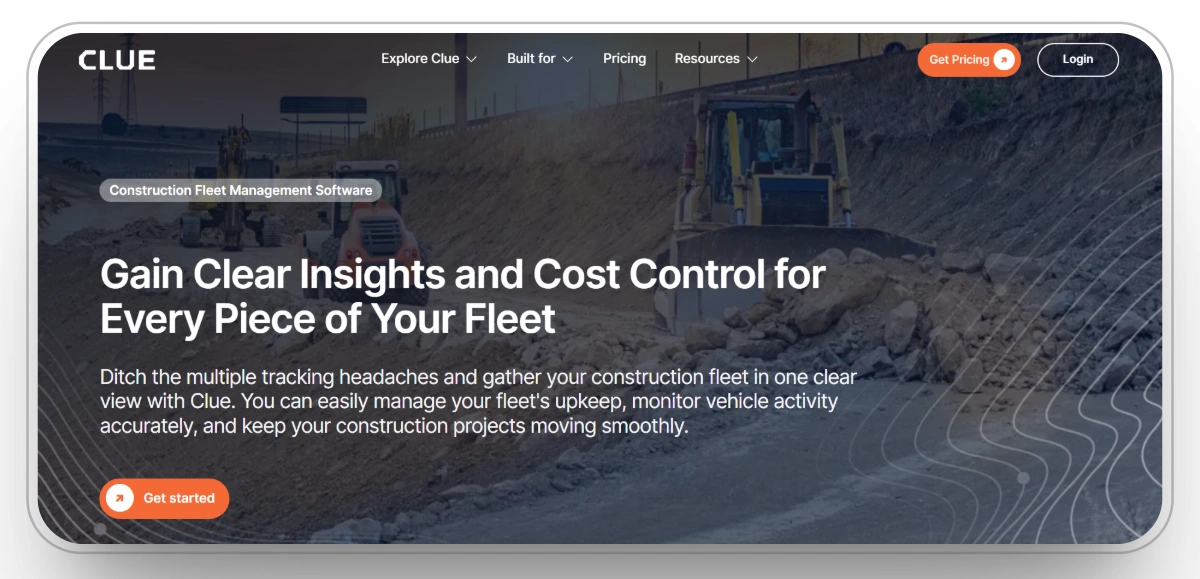
Clue makes day-to-day compliance simple by keeping inspections, repairs, documents, and driver information in one place and turning each step into a clear, auditable workflow.
Construction fleet management software can take this a step further by integrating with your existing tools, ensuring all aspects, from driver qualification to maintenance, are seamlessly managed.
One System of Record for Vehicles, Drivers, and Documents
Clue acts as a single place to manage equipment-side compliance.
It automates preventive-maintenance schedules, captures daily and DOT-style inspections (including DVIR with signature capture), and turns defects and telematics fault codes into mechanic work orders.
Keeping a complete, time-stamped repair and service history you can export as inspection PDFs when you need proof.
Inspections Flow Into Repairs, With Proof
Operators complete mobile eDVIRs with checklists, photos, and defect severity.
Once a defect is flagged, Clue will automatically create a work order, the shop will add parts and labor and technicians will add before-and-after photos. All the steps are time-stamped, so that you know how to trace the way to defects.
Hours-of-Service Exceptions and Follow-Ups
Clue can bring in HOS summaries and exceptions from your ELD or telematics provider.
Supervisors assign follow-ups, record coaching or retraining, and close items against the driver’s profile. This keeps HOS issues visible and documented without bouncing between systems.
Permits, Oversize Loads, and Securement Checks
Pre-trip checklists in Clue can reflect your oversize/overweight and securement requirements.
Permits, route surveys, and tie-down instructions live with the unit record, so field teams can pull what they need during roadside stops. The result is faster checks and fewer avoidable delays.
Audit Readiness and Instant Document Retrieval
Clue stores inspections, work orders, and documents in a quick-export format including PDFs of inspections with signatures and repair confirmations.
You can display what was checked, what was broken and how it was fixed and when the unit was put back in service. That degree of evidence reduces roadside chit-chat and eases audits.
Built for Construction Duty Cycles
Clue is built for fleets that operate in some of the toughest field conditions. It is job-based tracking, rough-duty PM schedules and role-based access in order that drivers, foremen, the shop and safety team can only see what they need.
Using mobile inspections that work with or without a network connection, rapid photo capture, and integrations with most ELD, telematics, and maintenance databases, compliance is transformed into a habit rather than a rushed scramble.
Construction-Specific Wrinkles You Should Plan For

Construction duty cycles are brutal on people and machines. Here are the jobsite realities, mixed drivers, short-haul nuance, OS/OW moves, you must account for to stay clean on the road.
- Mixed Fleets & Rotating Drivers: Service bodies, mechanics’ trucks, and temporary drivers complicate DQFs and vehicle files. Digitize who drove what, when, and keep unit-level proof of annual inspections and repairs. Guides recommend central repositories to prevent “lost paperwork” during audits.
- Work-Zone Realities: Frequent short moves can tempt HOS shortcuts. If you use the short-haul exception, train to its limits and be ready to switch to full RODS when you exceed radius/time.
- Oversize/Overweight Moves: Plan permits/routing early; build slack for inspection delays. Field chatter suggests tight projects often stumble here, don’t let the scale house set your critical path.
Conclusion
When you translate the rulebook into daily habits, qualified drivers with clean DQFs, HOS discipline backed by ELDs, inspections that trigger real repairs (not lip service), tight load securement and weight control, IFTA handled without drama, and records ready on demand, you turn risk into routine.
The payoff appears where it matters, less in fines and out-of-service hits, safer crews, more stable schedules, better insurance position, a reputation that gets bids rather than misplaces them.
Ready to make compliance routine?
Clue centralizes all inspections, photo-backed eDVIRs, preventive maintenance, and work orders and integrates your telematics data so that you can demonstrate compliance quickly and get the fleet back on the road. See how your team can complete a switch, of defect to documented repair, in minutes and not weeks.
Transform Your Equipment Management








